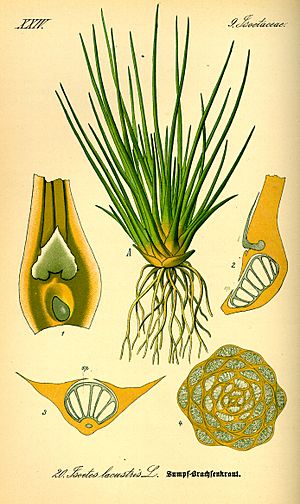Lake quillwort facts for kids
Quick facts for kids Lake quillwort |
|
|---|---|
 |
|
| Conservation status | |
| Scientific classification | |
| Genus: |
Isoetes
|
| Species: |
lacustris
|
| Synonyms | |
|
|
The lake quillwort, also known as Merlin's grass, is a special type of water plant. Its scientific name is Isoetes lacustris. This plant grows naturally in cool, northern areas on both sides of the Atlantic Ocean. Another name for it, Isoetes hieroglyphica, is actually the same plant.
Contents
What it Looks Like
The lake quillwort has many long, thin leaves. These leaves are usually about 8 to 20 centimeters (3 to 8 inches) long. They are narrow, only about 0.5 to 2 millimeters wide. However, they get wider at the very bottom, up to 5 millimeters.
At the base of each leaf, there is a small sac. This sac holds the plant's spores. The plant has a very short stem, called a corm. All the leaves and roots grow very close together from this corm.
Instead of regular roots, the lake quillwort has special modified leaves. These act like roots and are called rhizomorphs. They attach to the bottom of the corm. The green leaves grow upwards in a cluster.
How it Reproduces
Lake quillworts usually reproduce in late summer or early fall. The sacs at the bottom of the leaves make two different kinds of spores.
- Megaspores: These are the female spores. They are larger, about 0.5 millimeters across.
- Microspores: These are the male spores. They are much smaller, only a few micrometers in size.
These spores are part of the plant's life cycle. They help the plant create new plants.
Plant Classification (Taxonomy)
The Isoetes lacustris was first found by Johannes Reinke. Later, it was officially described by a famous scientist named Carl Linnaeus. For a while, Isoetes hieroglyphica was thought to be a different plant. However, scientists now agree that it is the same species as I. lacustris.
Where it Lives and Grows
In Europe, you can find the lake quillwort in many places. It grows from Poland in the east to northeastern France in the west. It is also found all over Scandinavia, in the west and north of the British Isles, and on the Faroe Islands and Iceland.
In North America, this plant lives in the New England states of Maine, Vermont, New Hampshire, Rhode Island, and Massachusetts. In Canada, it grows in New Brunswick and Nova Scotia.
This plant prefers to grow on the rocky or sandy bottoms of clear lakes. These lakes are usually a little bit acidic. You can often find them in mountain tarns, which are small mountain lakes. They grow in water that is 5 to 460 centimeters (about 2 inches to 15 feet) deep. Lake quillworts are perennial plants, meaning they live for many years. They usually grow new leaves twice a year, once in the spring and again in the autumn.
Uses of Lake Quillwort
The lake quillwort is one of the few types of quillworts that people grow. It is sometimes used as a plant in aquariums. It is also grown for educational purposes, helping people learn about aquatic plants.
See also
 In Spanish: Isoetes lacustris para niños
In Spanish: Isoetes lacustris para niños


